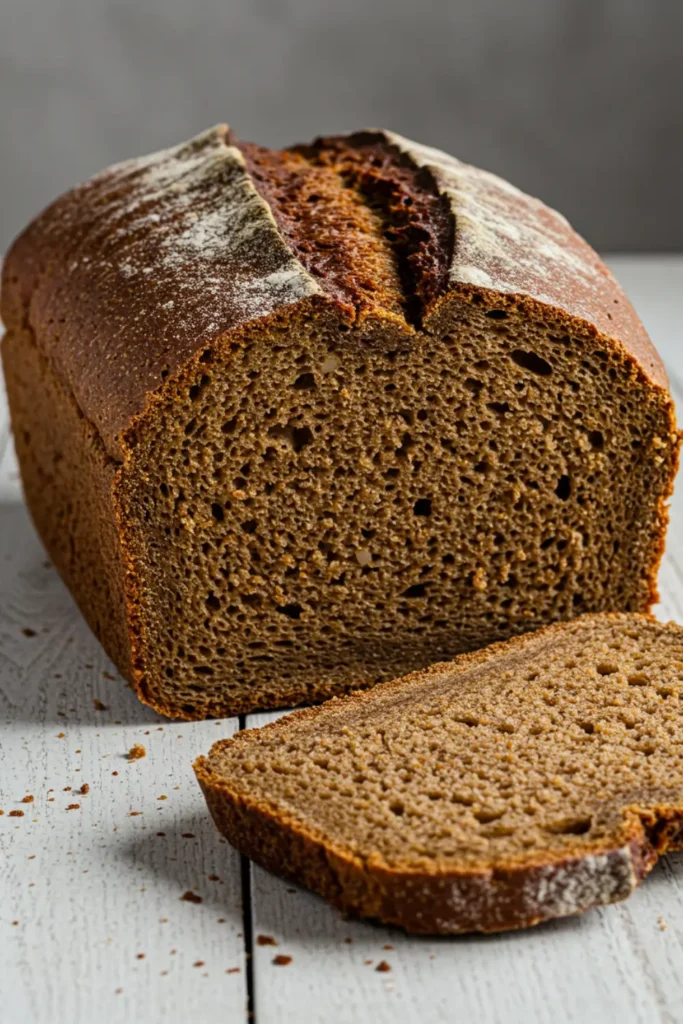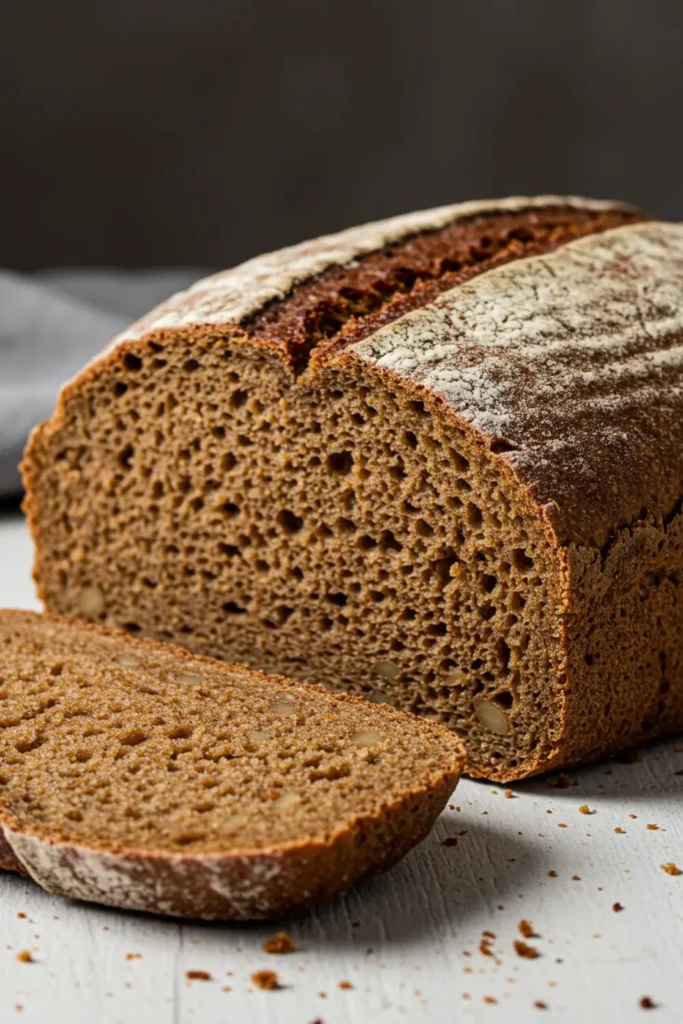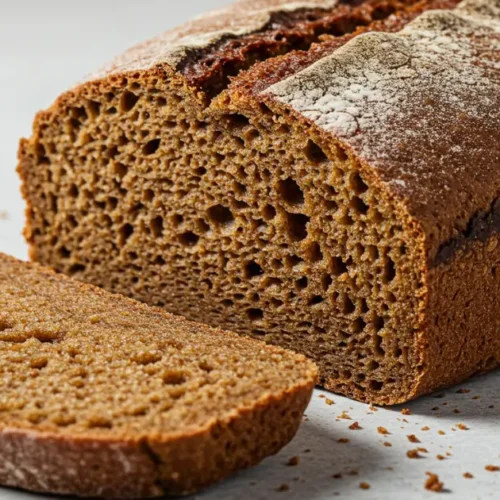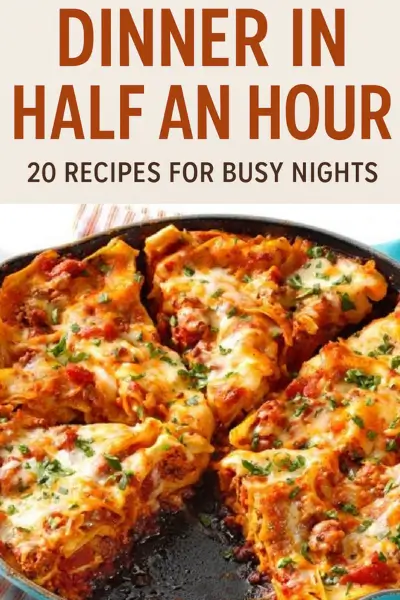This pumpernickel bread recipe is perfect for anyone who loves hearty, flavorful bread. Made with rye flour and molasses, it has a rich, earthy taste that’s perfect for sandwiches or enjoying on its own. The texture is dense yet soft, with a satisfying crust. Whether you’re new to baking or a pro, this easy-to-make bread will fill your kitchen with amazing smells and bring a delicious homemade touch to any meal.
Why We Love This
If you’ve ever had the pleasure of biting into a slice of freshly baked pumpernickel bread, you know exactly why it’s a kitchen favorite. This artisan bread isn’t just a treat for your taste buds—it’s also packed with history and flavor. Here’s why you’ll fall in love with it:
- Rich, Earthy Flavor: The combination of rye flour and molasses gives this bread its signature depth. It’s slightly sweet with a robust, hearty taste that’s both comforting and satisfying.
- Dense, Yet Soft Texture: Unlike lighter breads, pumpernickel has a satisfying, dense crumb with a perfect balance of moisture. Every bite is hearty but not heavy, making it perfect for sandwiches or toast with a bit of butter.
- Versatile for Any Meal: Whether you’re enjoying it as a side with soup, making a robust sandwich, or simply savoring it on its own, pumpernickel pairs wonderfully with many dishes. Its rich flavor complements everything from savory spreads to sweet jams.
- Health Benefits: Thanks to the use of rye flour, this bread offers more fiber and nutrients than traditional white bread. Plus, it’s a great source of antioxidants and can be easier to digest for those sensitive to wheat.
- Homemade Satisfaction: There’s something special about baking bread from scratch. It fills your home with comforting aromas and gives you a sense of accomplishment that store-bought bread just can’t match.
This pumpernickel bread recipe is simple enough for beginners but impressive enough to wow your guests. Once you try it, it’ll quickly become a go-to in your baking rotation!

Ingredients
Rye flour – Gives the bread its dense, earthy flavor.
Whole wheat flour – Adds texture and depth to the bread.
Active dry yeast – Helps the bread rise.
Molasses – Provides sweetness and color.
Caraway seeds (optional) – Adds flavor.
Salt – Enhances the bread’s taste.
Warm water – Activates the yeast.
Sugar – Helps the yeast activate.
Apple cider vinegar – Improves texture and flavor balance.
Olive oil – Adds moisture and richness.
Instructions
Now that you have all your ingredients ready, let’s get started on making this delicious pumpernickel bread. Follow these steps, and you’ll have a loaf of homemade bread with a perfect texture and rich flavor in no time!
Activate the yeast: Mix warm water and sugar, then add yeast. Let it sit for 5-10 minutes until bubbly.
Mix the dry ingredients: Combine rye flour, whole wheat flour, salt, and caraway seeds in a bowl.
Add the wet ingredients: Pour the yeast mixture into the dry ingredients. Add molasses, apple cider vinegar, and olive oil. Stir until a shaggy dough forms.
Knead the dough: Knead the dough on a floured surface for 8-10 minutes until smooth and slightly sticky.
First rise: Shape the dough into a ball, place in a greased bowl, cover, and let rise for 1-1.5 hours until doubled in size.
Shape the loaf: Punch down the dough, shape it into a loaf, and place it on a floured surface.
Second rise: Place the dough on a greased baking sheet, cover it, and let it rise for 30-45 minutes.
Preheat the oven: Heat the oven to 375°F (190°C).
Bake the bread: Bake for 30-35 minutes until it is golden brown and sounds hollow when tapped.
Cool and Enjoy: Let the bread cool on a wire rack for 30 minutes before slicing.

Pro Tips
To make sure your pumpernickel bread turns out perfectly every time, here are some tried-and-true tips that will elevate your baking game:
Use room-temperature ingredients: If possible, let your ingredients like molasses, vinegar, and olive oil come to room temperature before using them. This helps them mix more easily into the dough, ensuring a smoother texture.
Pay attention to the yeast: If you’re using active dry yeast, it’s important to let it foam before using. If it doesn’t foam, the yeast might be expired, and you’ll need a fresh packet for the dough to rise properly.
Don’t over-knead: Unlike some lighter breads, pumpernickel bread doesn’t require as much kneading. Knead just enough to form a smooth, elastic dough. Over-kneading can make the bread denser than intended.
Monitor your dough’s rise: The first and second rise times are just guidelines. Dough can rise faster or slower depending on your kitchen’s temperature. If it’s a cooler environment, give it a little extra time to rise.
Test for doneness: To check if your bread is fully baked, tap the bottom of the loaf. If it sounds hollow, it’s ready. If not, let it bake for a few more minutes. Every oven is different, so be patient!
Let the bread cool completely: As tempting as it is to slice into that fresh loaf right out of the oven, it’s best to let your pumpernickel bread cool on a wire rack for about 30 minutes. This helps the structure set, giving you cleaner slices.
Store it properly: To keep your bread fresh, store it in an airtight container or wrap it in a cloth bag. For a longer shelf life, you can freeze it in slices and toast individual pieces as needed.
Variations
One of the best things about pumpernickel bread is its versatility. While the classic version is delicious on its own, you can easily customize it to suit your taste or match whatever ingredients you have on hand. Here are some fun variations to try:
Add seeds for extra crunch: For a bit of texture, sprinkle sunflower seeds, flaxseeds, or sesame seeds on top of the dough before baking. These seeds add a delightful crunch and boost the flavor, making your pumpernickel bread even more interesting.
Herb-infused pumpernickel: Want to add a savory touch? Mix in fresh rosemary, thyme, or garlic powder into your dough for a fragrant, herb-infused loaf. The herbs complement the dense rye flavor beautifully.
Sweet pumpernickel: If you enjoy a sweeter twist, increase the amount of molasses or add a bit of honey. You could also mix in raisins or dried cranberries for a sweet, fruity version that pairs wonderfully with cream cheese or butter.
Serving Suggestions
There’s no shortage of ways to enjoy your pumpernickel bread once it’s fresh out of the oven. This hearty, flavorful loaf is perfect for a variety of meals and occasions. Here are some delicious serving ideas to make the most of your bread:
For a classic breakfast:
Toast slices of your pumpernickel bread and top them with a generous spread of cream cheese or butter. For extra flavor, add a drizzle of honey or some sliced tomatoes. It’s the perfect balance of savory and slightly sweet.
With soups and stews:
Pumpernickel bread makes a fantastic pairing with hearty soups like split pea soup, beef stew, or even a creamy potato leek soup. The dense texture and rich flavor of the bread hold up beautifully, perfect for dunking.
More Bread recipes you will love!
FAQs
Here are some common questions and helpful answers to ensure your pumpernickel bread turns out perfectly:
Can I use all-purpose flour instead of rye flour?
While all-purpose flour can be used in place of rye flour, it will alter the flavor and texture of the bread. Rye flour is key to achieving the dense, slightly earthy flavor of pumpernickel bread. If you don’t have rye flour, consider using a combination of whole wheat and all-purpose flour to get closer to the original taste.
How can I make my pumpernickel bread lighter?
If you’re looking for lighter pumpernickel bread, you can try using a higher proportion of bread flour and adding some vital wheat gluten. Additionally, incorporating a small amount of white flour into the dough can help lighten the texture without compromising too much of the traditional flavor.
Why is my pumpernickel bread so dense?
Pumpernickel bread is naturally denser than other breads due to the rye flour and the lack of high-gluten wheat flour. The density is part of its charm and authenticity, but if your bread feels excessively heavy, it could be due to over-kneading or under-proofing the dough. Make sure to knead just enough to bring the dough together and allow it plenty of time to rise.

pumpernickel bread recipe
Ingredients
- 2 cups rye flour
- 1 cup whole wheat flour
- 1 packet active dry yeast or 2 ¼ teaspoons
- 1 tablespoon molasses
- 1 tablespoon caraway seeds optional
- 1 teaspoon salt
- 1 cup warm water
- 1 tablespoon sugar
- 1 tablespoon apple cider vinegar
- 2 tablespoons olive oil
Instructions
Activate the yeast:
- In a small bowl, combine the warm water (around 110°F) with the sugar. Stir it to dissolve, then sprinkle the active dry yeast over the top. Let it sit for about 5-10 minutes or until the yeast is bubbly and foamy. This means it’s active and ready to work its magic in your dough.
Mix the dry ingredients:
- In a large bowl, whisk together the rye flour, whole wheat flour, salt, and caraway seeds (if using). This helps ensure the ingredients are evenly distributed before you add the wet ingredients.
Add the wet ingredients:
- Once the yeast mixture is ready, pour it into the dry ingredients. Add the molasses, apple cider vinegar, and olive oil. Stir everything together with a spoon until a shaggy dough starts to form.
Knead the dough:
- Transfer the dough onto a lightly floured surface and knead for about 8-10 minutes. You’re looking for a smooth and slightly sticky dough that’s firm enough to hold its shape. If the dough feels too sticky, add a little more rye flour, but be careful not to overdo it—pumpernickel bread should be a bit denser than regular bread.
First rise:
- Once kneaded, shape the dough into a ball and place it in a greased bowl. Cover the bowl with a clean towel or plastic wrap, and let the dough rise in a warm spot for about 1-1.5 hours or until it has doubled in size.
Shape the loaf:
- After the dough has risen, punch it down gently to release the air. Transfer it to a lightly floured surface and shape it into a loaf. You can either shape it into a round or an oval loaf, depending on your preference.
Second rise:
- Place the shaped dough onto a greased or parchment-lined baking sheet. Cover it again and let it rise for another 30-45 minutes or until it has puffed up again.
Preheat the oven:
- While the dough is rising, preheat your oven to 375°F (190°C). A well-heated oven is crucial for achieving that perfect crust on your bread.
Bake the bread:
- Once the dough has finished rising, bake it in the preheated oven for 30-35 minutes. The bread should be golden brown, and when you tap the bottom, it should sound hollow—this means it’s fully baked.
Cool and enjoy:
- Let the bread cool on a wire rack for at least 30 minutes before slicing. This helps the texture set, so you get the best results when you cut into it.
Send me this recipe!
Just enter your email below and get it sent straight to your inbox!


